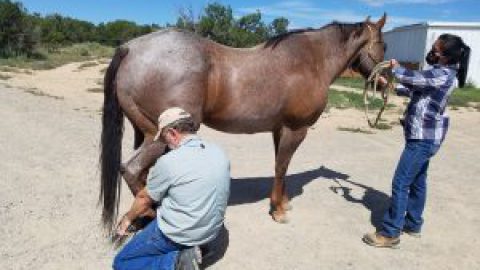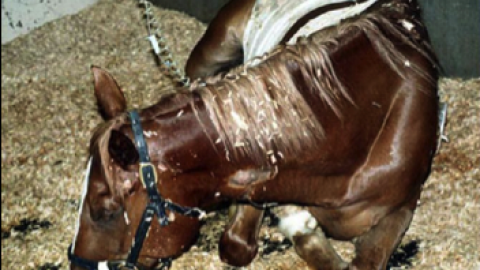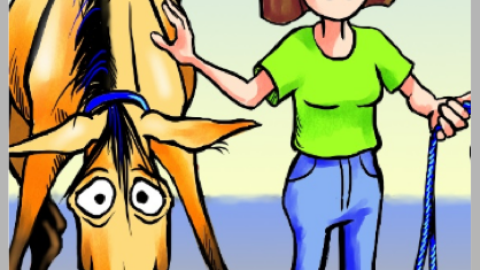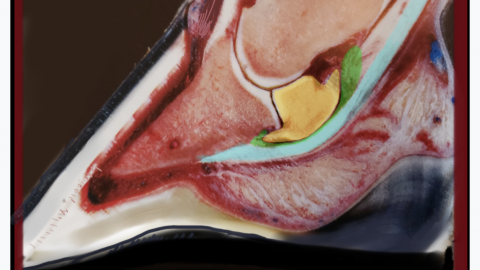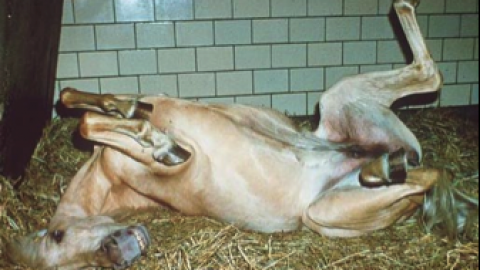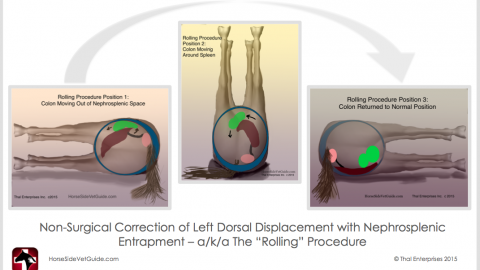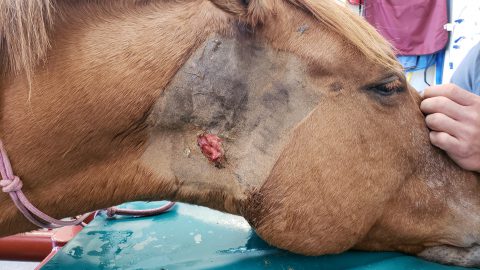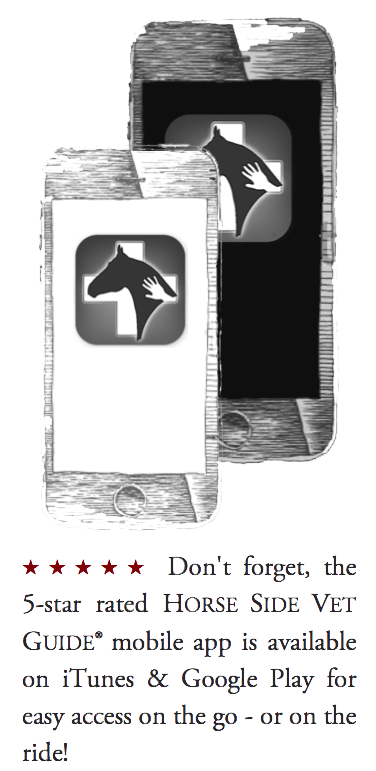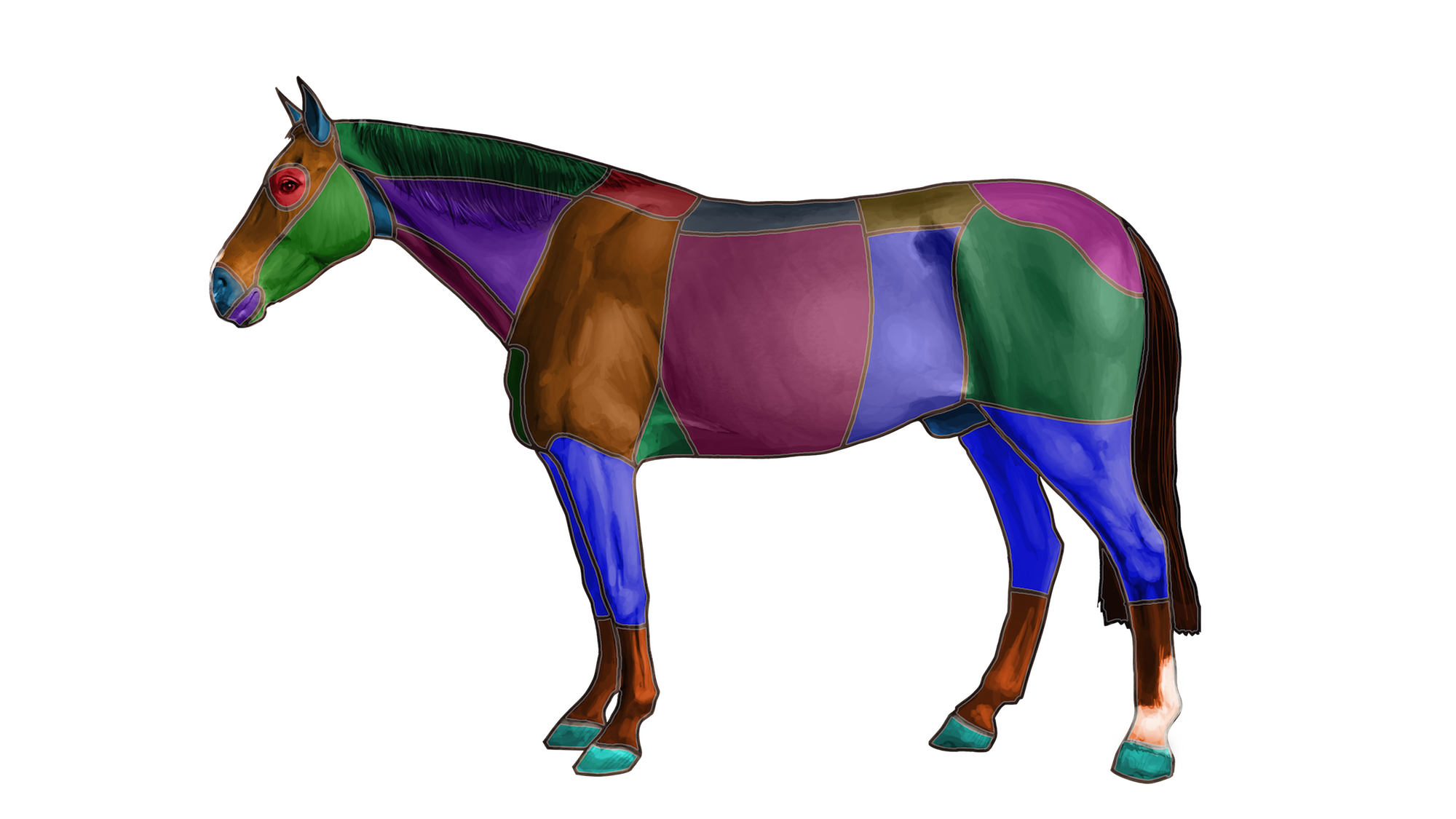Injecting Your Horse Can Be Hazardous. Know the Risks!

This is Sunny, a recent patient in our equine hospital. We had to make multiple fasciotomies (incisions deep into muscle and fascia) in order to control Clostridial Myonecrosis, a life-threatening bacterial infection.
Sunny, a 10 year old paint gelding, was given his routine vaccinations. A day later, there was some swelling at one of the injection sites in his neck. After talking to her veterinarian, the owners gave him some bute. He seemed to improve for a while, but suddenly the swelling worsened, he spiked a fever of 104, and he stopped eating. Within hours, his entire neck, head and front legs swelled. Crackling could be felt under his skin from gas accumulation. The swelling quickly migrated over his body, and he began to go into shock. The referring veterinarian recognized this as a life-threatening condition and promptly referred Sunny to us for care.
The condition is called Clostridial Myonecrosis and it is often fatal and always very difficult to treat. Along with potent IV antibiotics and nursing care, the only way to effectively treat it is to rapidly and aggressively cut through the muscle and fascia in multiple locations, draining the infected tissues and opening the anaerobic (living where there is no oxygen) Clostridium organism up to oxygen.
Sunny almost died. He was hospitalized at our veterinary practice for 10 days and at the cost of thousands of dollars. This case reminded me to share with you some of the risks of injection. It’s not my purpose to scare you, but only to make you aware and to encourage you to use good technique and only inject your horse when it’s really needed.
![]()
Intramuscular “IM” Injections
It seems like a no-brainer, a simple muscle injection in the neck. But if something goes wrong, it can be a disaster! IM injections should be performed correctly.
First off, whenever you give an intramuscular injection, there is ALWAYS the possibility of a local reaction of heat and swelling. This is usually an excessive immune response, and it is usually short-lived and can be helped by anti-inflammatory medication and a little time. It’s similar to you having swelling and pain in your arm after a flu shot, and being relieved by taking some ibuprofen.
This is in contrast to a careless or poorly performed injection that unnecessarily damages tissue and sets up the condition for infection, abscess, or worse. Sadly, I have seen dozens of poorly performed injections. The most common of these is injection too low in the neck, into the vertebral column instead of the muscle, creating unnecessary injury and suffering. How can you minimize problems? Learn how to perform IM injection correctly. Head and Neck, a reference image in Horse Side Vet Guide. Many horse people don’t realize just how low the vertebral column runs in the neck.
Simple injection site inflammation and irritation can be confused with more serious problems. Interestingly, a study has shown that there are Clostridium bacterial spores dormant in the muscle tissue of many healthy horses. If an IM injection causes irritation or muscle damage, the right conditions can develop for activation of these dormant spores, turning them into reproducing bacteria. As demonstrated by Sunny, life-threatening Clostridial Myonecrosis results.
Flunixin (Banamine®), commonly given by horse people, is actually NOT intended to be injected into the muscle, but is only intended for intravenous use. Flunixin causes local muscle damage and can create an increased risk of Clostridial infection. Learn more about flunixin and phenylbutazone here.
Speaking of bute, you surely know you CAN’T inject that into the muscle! Injectable bute destroys tissue, and the tissue around the injection site will usually swell and then sluff out, leaving a giant hole! Unless you are a confident professional, you should only give phenylbutazone orally.
Intramuscular injection of procaine penicillin is common in the horse world. You may have given dozens of penicillin shots, but have you ever seen a procaine reaction? In that condition, you give intramuscular penicillin and a minute or so later, the horse begins twitching and snorting, and spinning around in the stall. In a severe procaine reaction, the horse might even have a seizure, fall down and scramble in place. This scary condition lasts for a couple of minutes, but it feels like an eternity.
People often incorrectly call procaine reaction an “allergic reaction”, but it is actually a reaction to the procaine carrier in the penicillin. It usually occurs when procaine gets into the bloodstream too rapidly, most commonly because of inadvertent injection into a vessel. That is why it is so critical to draw back when you are giving intramuscular injections, to be sure the tip of the needle is not in a vessel. But even this is no guarantee. Procaine reactions happen more commonly when multiple injections are given at a site over time.
A true full-blown, body-wide allergic reaction is called an anaphylactic reaction. Anaphylaxis usually takes minutes to hours to develop and can range from hives to life-threatening shock. Horses suffering from severe anaphylaxis go off feed, look distressed, and breathe hard. Their head may swell and they may get hives. They sometimes develop diarrhea and/or colic, and they can go into shock and will die if they don’t get quick veterinary help.
Intravenous “IV” Injections
Good morning Doc…. Jake wouldn’t stand for the farrier. So I decided to “give him a little shot of Rompun® in the vein”. Next thing I knew Jake went straight up and landed 10 feet away, on his back! Now he is lying on the ground kind of running in place, with his eyes rolled back in his head and he’s bleeding from his nose and ears. Why did he get that allergic reaction doc? What should I do now?
Well, Johnny, you gave your horse a shot into the carotid artery.
I don’t believe in teaching non-professionals to give IV injections, except under VERY specific circumstances. You will not find this Skill taught in Horse Side Vet Guide. Here’s a caveat: If you are the caretaker for more than 50 horses on a daily basis, then it makes sense to learn to give IV injections. Otherwise, you are better off not. Why? It’s not a difficult skill, but if you only do it infrequently, the likelihood of making a mistake is high. The greatest risk of IV injection is accidental injection into the carotid artery, which lies very close (just deep) to the jugular vein.
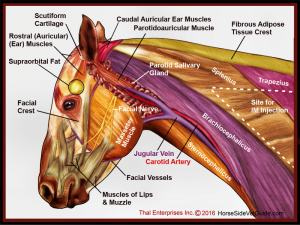
In this illustration you can see just how close the carotid artery is to the jugular vein. You need to be aware of this when you give IV injections. This, and many other helpful illustrations are available on the Horse Side Vet Guide mobile app – THE best $5 you can spend on your horse!
An intracarotid injection is a pretty terrifying thing to see. Usually the horse goes into an instantaneous and full-blown seizure. It happens so fast you have no chance to react. Horses often flip over backward and land on their back and head. The trauma resulting can be fatal. There’s also a serious risk of mortal handler injury. How does it happen? The carotid artery lies right next to and deep to the jugular vein. Its surprisingly easy to penetrate through the jugular and inject into the artery. I know. I have done it a few times.
And then there is the issue of just plain missing the vein and injecting into the tissues around it. Of course if you miss the vein, then you don’t get the desired response. But many injectable medications are ALSO very irritating to the tissues and may cause swelling and pain at the site. The damage might even lead to things like jugular thrombosis, or damage to the other vital anatomy in that important area.
So what can you do to prevent these problems?
Don’t give your horse an IV injection unless you are an experienced professional.
In Summary:
• Be sure you know how to properly give an IM injection! A poorly given injection is a LOT MORE likely to lead to problems.
• Give any medication to your horse under veterinary guidance.
• Be sure medications are really needed and appropriately tailored to the problem, i.e. the diagnosis.
Realize that anytime you put a needle into a horse, there is a small risk. As a horse owner or caretaker, the most important thing you can do is know those risks, and if you are going to inject, then use proper technique. Here is our intramuscular injection video and the accompanying IM injection skill.
Sometimes I remind trainers and others (who might have injected quite a few horses) about these risks. They can be pretty confident that these things won’t happen to them. All I can say to them is: “You just haven’t injected enough horses.”
![]()
By Doug Thal, DVM DABVP. Certified in Equine Vet Practice, Creator of Horse Side Vet Guide
Dr Thal is an equine veterinarian who has been in practice for 24 years. Over that time, he has worked to help thousands of horse people better understand their horses physically and mentally, and better understand how to get the most from their equine vet. To do this, he created a Smartphone app for horse people called Horse Side Vet Guide. It’s the most highly rated equine health app in the world and a GREAT tool to help you care for your horses. You should have it on your phone! Learn more here!




